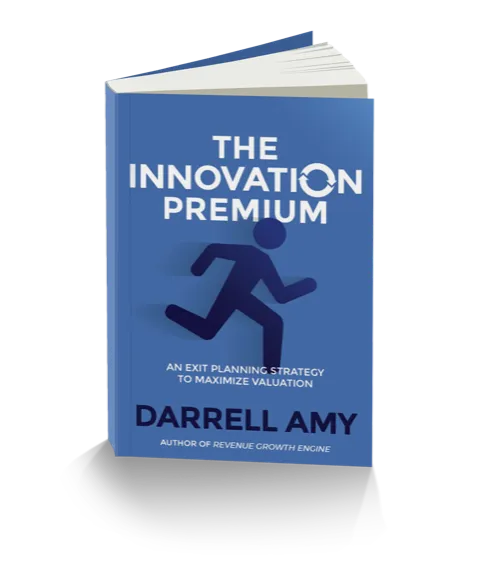THE VALUE CREATION BLOG

How Process Optimization Drives Higher Valuation
When it comes to boosting business value, many leaders instinctively turn to revenue growth. While a strong Revenue Growth Engine® undeniably matters, optimizing business processes can significantly enhance—or even surpass—revenue growth in terms of multiplying valuation.
Businesses ultimately consist of two core elements: people and processes. Processes represent the series of steps required to achieve consistent outcomes. They are the routines and actions repeated daily in your business, creating predictable results. For this reason, processes are crucial, as they directly affect every part of a business—from profitability to employee and customer satisfaction.
As any EOS® fan will tell you, processes need to be “documented and followed by all.” This ensures consistency and clarity, setting the foundation for effective operations. However, documenting processes alone isn’t enough. Many companies miss the next, vital step: process optimization.
Optimizing processes involves regularly examining core business operations and asking key questions:
How could we do this better?
How could we improve this process to deliver a better customer experience?
How could we integrate technology to make this process more efficient?
How could we simplify the process?
By addressing these questions and striving for continuous improvement, companies can uncover opportunities to increase efficiency, reduce costs, and enhance customer and employee experiences. Optimized processes help companies become more competitive, resilient, and ultimately more valuable, making process optimization a powerful multiplier for business valuation.
Let's explore five ways optimized processes can maximize your business's valuation:
1. Reduce Expenses to Maximize Profit
Streamlining business processes reduces expenses, ultimately boosting profitability. In companies where processes are outdated or inefficient, tasks take longer, wasting valuable resources. A study by McKinsey found that organizations adopting process optimization and automation can reduce operational costs by up to 30% (McKinsey & Company, 2020). Optimized processes allow companies to increase output per employee—a key efficiency metric. This improvement is measured in the revenue-per-employee ratio, a critical indicator that potential buyers assess when valuing a business.
To illustrate, consider two businesses in the same industry, each generating $10 million in revenue. One company has a 10% profit margin, while the other, through continuous process optimization, achieves a 20% profit margin. With an industry valuation multiple of 5x EBITDA, the first business would be valued at $5 million ($1M EBITDA x 5). The second business, with optimized processes and a 20% profit margin, would be worth $10 million ($2M EBITDA x 5). This 100% valuation increase is purely due to process efficiency.
2. Improve Employee Experience to Boost Engagement
One of the main reasons employees leave companies is frustration, often stemming from inefficient or chaotic processes. According to a Gallup survey, 63% of employees feel disengaged, with poor process management contributing to their dissatisfaction (Gallup, 2023). Efficient processes create a work environment where employees feel productive and effective, reducing frustration and enhancing engagement.
Process optimization also creates an atmosphere where employees can see the tangible impact of their work, further boosting morale. Engaged employees are more likely to stay, and their higher productivity directly influences the company’s profitability and attractiveness to potential buyers.
3. Enhance Customer Experience to Increase Retention
Customer retention is crucial to sustaining and growing business value. Research by Bain & Company shows that increasing customer retention by just 5% can boost profits by 25% to 95% (Bain & Company, 2019). Unoptimized processes can create delays, errors, and inconsistent customer experiences, which drive customers away.
In "Never Lose a Customer Again," Joey Coleman highlights that new customers decide within the first 100 days whether to remain loyal. When customers encounter poor processes, they are more likely to look for alternatives, affecting renewal rates and cross-sell opportunities. A streamlined process improves customer satisfaction, leading to increased retention rates and, in turn, a higher valuation.
4. Facilitate Measurability and Continuous Improvement
A well-documented and optimized process is measurable, allowing a company to establish benchmarks and track improvements over time. For example, companies that use process optimization frameworks like Lean or Six Sigma can reduce defect rates by as much as 50%, enhancing both efficiency and quality (Lean Enterprise Institute, 2021). With real metrics, companies can identify areas for further enhancement, demonstrating to potential buyers that the business is structured for sustained growth and adaptability.
5. Increase Readiness and Attractiveness for Sale
Optimized processes make a business more appealing to potential buyers. Buyers value companies that can operate independently of their original owners or key employees, as they present lower risks. A business with documented, efficient processes offers a clear path for scaling and transitioning, increasing both its readiness and attractiveness for acquisition.
According to a survey by PwC, 82% of private equity investors consider process maturity as a major factor when evaluating acquisition targets (PwC, 2022). Businesses with optimized processes are not only more valuable but also more likely to sell at a premium.
Conclusion
While growing revenue is essential, optimizing processes can amplify the impact of your revenue efforts, ultimately boosting your business's valuation. The Process Optimization Engine, a core part of the Value Creation Engines framework, is designed to establish a structured cadence for evaluating and refining business processes. This framework helps companies move beyond simple documentation, providing a systematic approach for regular process evaluation and improvement.
With the Process Optimization Engine, companies gain a routine for assessing core processes, identifying inefficiencies, integrating new technologies, and ensuring that every step contributes to a streamlined, profitable operation. This cycle of continuous optimization not only reduces costs and improves customer and employee satisfaction but also prepares the business for scalable growth and enhances its attractiveness to potential buyers. By investing in the Process Optimization Engine, companies can foster sustainable growth, drive higher profitability, and create a robust foundation for long-term valuation maximization.
Originally published on Darrell Amy's LinkedIn.
FREE BUSINESS VALUATION
What is Your Business Worth?
You can Discover the Value of Your Business in Less than 20 Minutes!
Join 70,000 business owners and get your score on the 8 Factors That Drive Your Company’s Value, a comprehensive analysis of your score and a detailed action plan for how to improve your score on each.


PREORDER YOUR FREE COPY NOW
Discover How to Create a Premium Valuation for Your Business
Learn how to command a premium multiple on your business
Find out why buyers discount their offers
See how innovation can help you create a premium valuation
Estimate your company's innovation index



